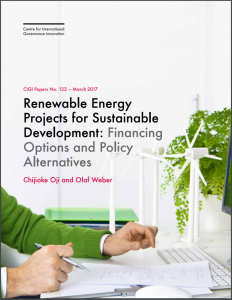Full Title: Renewable Energy Projects for Sustainable Development: Financing Options and Policy Alternatives
Author(s): Chijioke Oji and Olaf Weber
Publisher(s): Center for International Governance Innovation
Publication Date: March 1, 2017
Full Text: Download Resource
Description (excerpt):
To further the dissemination of decentralized renewable energy in order to address climate change and access to energy in developing countries, finance is needed. This paper presents a summary of available options for financing renewable energy development and alternatives for policy implementation to support this process. Debt and equity financing options are highlighted and selected policy frameworks for promoting investment in renewable energy project (REP) development are discussed as well. Specifically, the paper uses case studies of renewable energy programs in three different countries to examine financing possibilities and policy options for governments developing renewable energy programs. The renewable energy programs investigated in this study are the feed-in tariff (FIT) program in Ontario, Canada, the clean energy auction program in Mexico and the renewable energy independent power producer procurement program (REIPPPP) in South Africa. While the three programs share a number of similarities, there are also some differences, in particular in the design of the renewable energy programs.
A comparative analysis of these renewable energy programs showed that all three programs were implemented to diversify the energy supply mix, while reducing greenhouse gases (GHGs), with an overarching objective of a transition to low-carbon energy systems as part of a broader agenda of fostering sustainable development through an increased supply of renewable energy. In essence, objectives for the renewable energy programs were aligned with national or provincial economic development plans, climate change policies and the major energy plans in the province or country. The study suggests that in establishing a renewable energy program, different renewable energy policies may attract investment. However, the design of the policy and the method of implementation are critical in attracting investment necessary for the success of a renewable energy program. In addition, the study finds that due to the risks associated with financing large-scale REPs, financiers mostly prefer to finance REPs using project finance as a means to alleviate investment risks while making reasonable returns on capital invested for project development. Finally, since most renewable energy programs focus on large-scale REPs to develop renewable energy programs, governments can learn from Ontario’s microFIT program and incorporate small-scale REPs into their programs. These smaller REPs can make great contributions to GHG reduction while advancing the agenda for sustainable development in developing countries
